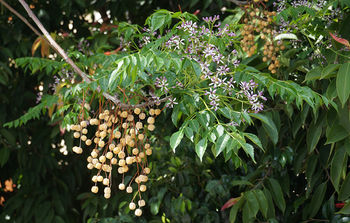White Cedar
Other Names : Melia azedarach, Barbados lilac; China tree; Chinaberry tree; Persian lilac; pride of India; umbrella tree; white cedar, arbol del paraiso; jacinta; paraiso, azedarach; lilas des Antilles; lilas des Indes, goda neem, arvore-santa; cinamomo; jasmim-de-cachorro; jasmim-de-soldado; lilás-da-India; para-raios, dâk' hiën; sdau khmaôch, Paternosterbaum; Zedarachbaum, arebevu; bakam-limdo; bakarja; bakarjan; bakayan; bakon-limdi; betain; bokain; chik-bevu; deikna; dek; deknoi; drek; ghora nim; gowdnim; heb-bevu; hutchubevu; kadbevu; kaliyapa; karin vembu; kattu veppu; mahaneem; makanim; malla nim; mallay vembu; padrai; pejri; puvempu; sima veppu; taraka-vepa; thamaga; thurakavepa; turka; vaymbu; vilayati nim; yerri-vepa, mindi, gringging, marambung, albero dei paternostri, h'ienx; kadau s'a:ngz, mindi kecil Netherlands: galbessen; paternosterboom, bakain; white cedar, bagaluñga; balagañgo; paraiso, mindi kechil, khian; lian, xoan
Special Precautions of White Cedar
Melia azedarach is often confused with the neem tree Azadirachta indica, to which it is related. A. indica easily be distinguished by the absence of stellate leaf hairs, pinnate leaves (not bipinnate as in M. azedarach), 3-lobed stigmas (not 5-lobed) and 1- to 2-seeded drupes (not up to 5-seeded).
Health Benefits and Uses of White Cedar
The whole plant or its specific parts (leaves, stem, and roots) are known to have medicinal properties and have a long history of use by indigenous and tribal people in India. Melia azedarach is used as an ayurvedic medicine in India and Unani medicine in Arab countries as an antioxidative, analgesic, anti-Inflammatory, insecticidal, rodenticidal, antidiarrhoeal, deobstruent, diuretic, antidiabetic, cathartic, emetic, antirheumatic and antihypertensive. It is highly nutritious having a calorific value at 5100 kcal/kg.
- Bark : Antidiarrhoeal, deobstruent, diuretic(Joy et al.,1998) rheumatic pain, used in fever to relieve thirst, nausea, vomiting and general debility, loss of appetite, stomachache. (Rahmatullah et al., 2010) Bark decoction is used as a remedy for fever aches and pains,(Kokwaro et al.,2009, Najma Dharani et al., 2010) Bark paste is used to treat piles,[22] used as lotion on ulcers, syphilitic (Way &Brandwijk. 1962; Sen et al., 2010)
- Stem : Asthma (Sen et al., 2010)
- Stem bark : infusion Used for gonorrhea, treat malaria and to expel parasitic worms (Dharani et al., 2010)
- Root : Roots are bitter, astringent, anodyne, depurative, vulnerary, antiseptic, anthelmintic, constipating, expectorant, febrifuge, antiperiodic, and bitter tonic in low doses.( Sen et al., 2010)
- Root Bark : As anthelmintic, used to treat malaria(Dharani et al., 2010, Handa et al., 2006)
- Leaves : Control many insect, mite and nematode pests, Antidiarrhoeal, deobstruent, diuretic.(Joy et al., 1998) Used as fodder and are highly nutritious, Skin diseases like scabies, for brushing teeth, loosening or pain of tooth, rheumatic pain, fever, insecticide,(Rahmatullah et al., 2010) applied externally on burns, used as mouth wash for gingivitis; pyrexia and bloody piles,(Khan et al., 2011), hysteria(Kaneria et al., 2009;Husain et al., 2008) snake bite, (Handa et al., 2006) diabetes, cure pimples, blood purifier.(Sultana et al., 2011) Leaves are used in anemia, eczema and measles, jaundice, treat malaria and to expel parasitic worms. Decoction is used as astringent and stomachic (Sen et al., 2010)
- Fruit : Fruits are used for the preparation of tonic which is purgative, emmolient. (Sen et al., 2010) Fruits are sweetish, and though said by some to be poisonous, is eaten by children without inconvenience, and is reputed to be powerfully vermifuge (Cropley. et al., 2007)
- Dried ripe fruit : Used as external parasiticide, pericarp of fruit is very effective phytotherapy for the treatment of diabetes(Sultana et al., 2011, Ahmad. et al., 2011)
- Flowers : Effective against bacterial skin diseases in children including cellulitis, pustules, and pyogenic infections. (Rahmatullah et al., 2010, Saleem et al., 2008) They are used as astringent, refrigerant, anodyne, diuretic, resolvent, deobstruent and alexipharmic ( Sen et al., 2010)
- Flower oil : Antidiarrhoeal, deobstruent, diuretic (Joy et al., 1998)
- Seed : They are bitter, expectorant, anthelmintic and aphrodisiac and are useful in helminthiasis, typhoid fever, pain in the pelvic region and scrofula (Sen et al., 2010)
- Seed oil Used as antiseptic for sores and ulcers. It is also used rheumatism and skin diseases such as ring worm and scabies. Internally the oil is useful in malaria fever and leprosy (Khan et al., 2011)
- Paste of Fresh fruits and leaves It is given to cattle twice a day for 2-3 days to treat gas trouble and indigestion (Abbasi. 2010)
- Whole plant Used to stimulate hair growth, (Stillé, 1860) treat eruption of scalp
- Also, it is used to manufacture agricultural implements, furniture, plywood, boxes, poles, tool handles and fuel wood. It is widely planted as a shade tree in coffee and abaca (Musa textilis) plantations. It is a wellknown ornamental tree.
